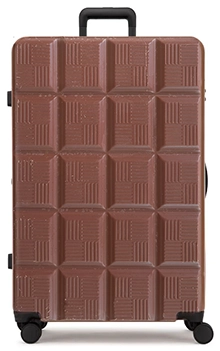In the past few months I have tried chocolate from a few countries that might not spring to mind for chocolate. But first: Reviews of some chocolate from classic chocolate destinations.
Chocolaterie Vandenbouhede
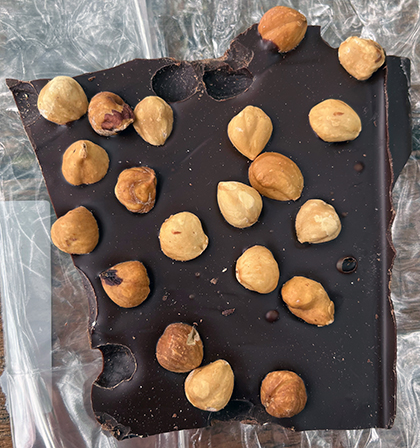
Now that people are venturing out again, a friend shared some Belgian chocolate bark they bought on their late-summer-boating-through-the-canals-of-Northern-Europe adventure. Sure I wish I could have gone myself, but having someone bring back chocolate seems like the next best thing.
The bark by Chocolaterie Vandenbouhede in Ghent came in dark and milk chocolate and was covered with whole roasted hazelnuts. Our friend said it cost $100 a kilo — I’m an American so frustratingly that reference meant nothing to me. I had to Google the conversion: 1 kilogram = 35.274 ounces. $100 divided by 35.274 = $2.83/ounce. Typical artisan bar weighs around 2.5-3 ounces so about $7–$8.50 a bar. Sounds like a pretty good deal.
The packaging was nothing special — plastic bags with information printed on the stickers that sealed the bags — but the chocolate looked good, not too thick not too thin with lots of hazelnuts.
Both barks required chewing to get them melting but the whole hazelnuts required chewing anyway so it’s all good. The dark chocolate was smooth, really tasty, and made of quality ingredients. The roasting made the hazelnuts extra hazelnut-y tasting, and the balance was right between the chocolate and nuts. The milk chocolate was too sweet for us and surprisingly hard for a milk chocolate. Dark is definitely the way to go.
Our friend said the staff at Bookz & Booze in Ghent recommended Chocolaterie Vandenbouhede and told him they make their chocolate on site. The bark isn’t available on their website — you now have an excuse to travel to Ghent — but they do have bars, bonbons, and other chocolate treats.
Chocolat Bonnat
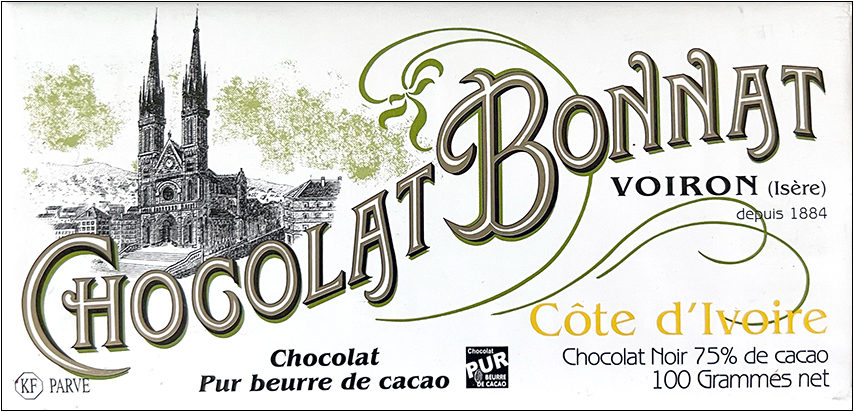
A Dandelion Chocolate-loving friend shared a single origin bar from another maker she likes — maybe just as much. She told us she buys French chocolate maker Chocolat Bonnat’s bars at Tahoe City Chocolates because she goes there often but Chocolate Covered SF carries a selection of Chocolat Bonnat bars too so we can get them locally.
The bar she shared was their 75% dark made from Côte d’Ivoire cacao. It had a hard snap and smooth texture. It was very chocolatey and nutty initially, a little bitter and not too sweet. Trying it a second time it was more earthy and fermented tasting reminding me of tobacco but not overpoweringly so. It also had a “crispy brownie edge” flavor that I’d first heard of in TCHO’s advertising but hadn’t experienced until this bar. It’s a distinct single origin bar.
Nói Sírius
Our friend also shared an Icelandic chocolate bar that she bought at Tahoe City Chocolates: Noi Sirius started as a candy company over 100 years ago and started making chocolate in the 1930s. They make a lot of old school Nordic candies — so much licorice — but they started a line of Traditional Icelandic Chocolate 10 years ago that includes the bar we tried.
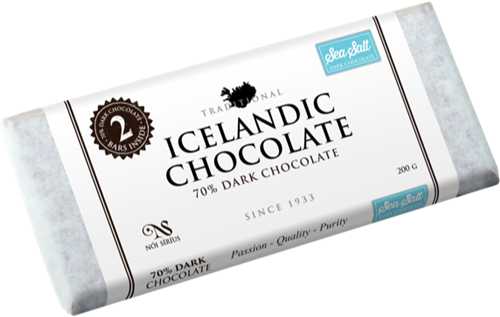
The bar she shared was a 70% Dark Chocolate with Sea Salt. It had a medium snap and tasted like fudge and salt initially. It was a little grainy from the salt and had some big flakes of salt too. It became more bitter and salty as the chocolate and salt flakes melted, with coconut and licorice (maybe power of suggestion? Cross contamination at the factory?) overtones. The chocolate has a good flavor but unless you really like salt I would stick to their unsalted choices.
I couldn’t find any info on where they source their cacao but according to their website their chocolate has been certified by Cocoa Horizons, which means “the cocoa beans are grown responsibly through sustainable farming.”
Public Chocolatory
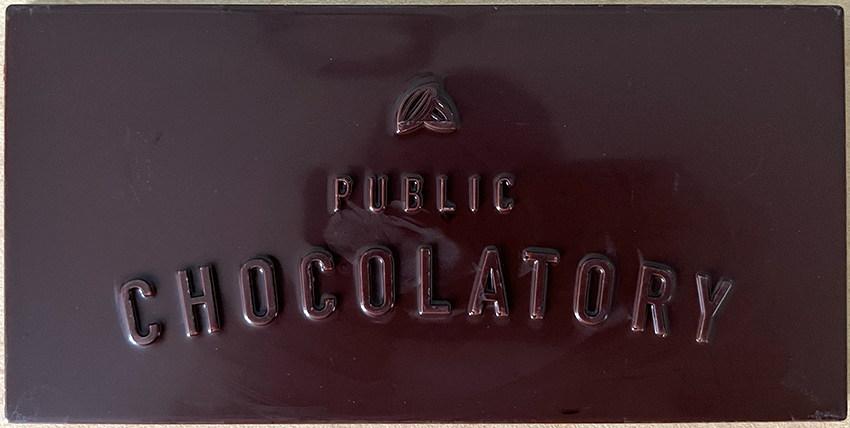
When I dragged my sister around on a chocolate death march this past August, I included a stop at Chocolate Covered, the wonderful shop in SF that sells over 1000 different bars from around the world. When I asked Jack what’s new, he told me he had just gotten in some bars from South Korea.
If you know me then you know that was all it took to get me to buy these bars — Kpop and every other touchstone of Korean culture are all conversation starters with me (you have been warned). But in the same breath Jack mentioned they were pricy. In fact he mentioned it several times as he led us over to the display.
He had four bars from Public Chocolatory, a Korean micro batch chocolate maker. In my eyes the Korean chocolate scene has developed rapidly. When Cacaopod and I visited Korea the first time in 2009 the only “high end” chocolate we could find was the kimchi flavored gift chocolate in the basement of the Lotte department store in Seoul.
The second time we visited Seoul in 2016 there were more chocolatiers and chocolate cafes than we could list. And now Korean bean to bar chocolate makers! Or as they have labeled themselves “vintoba” or “bintoba” chocolate. Clever.
Public Chocolatory started in December 2016 so we just missed its beginnings and it has since become one of the more established bean to bar makers in Korea. Even so it is still small enough that the founder and head chocolate maker Hanbin Paek delivered this latest batch of bars to Chocolate Covered herself.
Of the four bars, 2 were single origins and 2 were infused chocolate. We tasted them with a couple of fellow chocolate lovers and while we all enjoyed them they stretched our descriptive abilities with their complexity.
Single origin Vintuba chocolate
The 2 single origins were both 70% cacao with a shiny surface and good snap. They both had a smooth texture and weren’t bitter but were somewhat astringent.
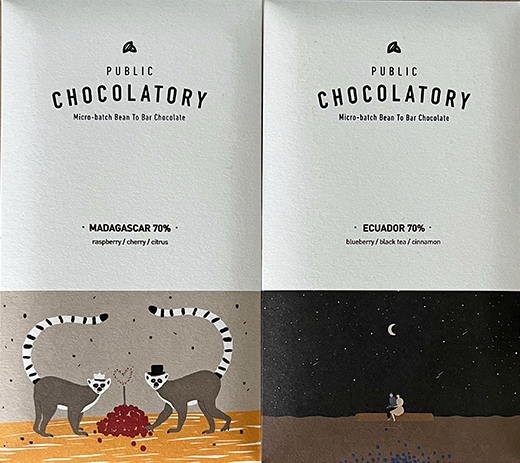
The Madegascar was very aromatic with sour fruit/citrusy notes. It was so astringent it made my mouth pucker but we all liked its dried cherry notes. Trying it a second time it was still cherry and astringent but more savory.
The Ecuador had a softer break and wasn’t as aromatic but had a scent of alcohol that reminded us of rum. The flavor was unusual — kinda smoky then distinctly sweet that became astringent and fermented at the end. We loved its creamy smooth texture and complex flavor. When I tried it a second time I decided the flavor was buttery raisin with a nutty aftertaste. While we liked both bars the Ecuador was more favored for its unusual and complex flavor.
Inclusion chocolate
The other 2 bars also had a good snap and smooth texture but were flavored bars. Origins weren’t listed — at least not in the English text on the packaging so I think these bars are made with house made couvertures.

The Masala Chai bar was a 55% milk chocolate. It had a softer break than the single origins and an immediate chai taste. Ingredients included black tea, cardamom, star anise, clove, and ginger. It definitely had a ginger flavor and bite, and as one of my tasters said, “Spicy! Yea!”
It was a milky tasting milk chocolate with a strong tea flavor under the spices that made it a little bitter for a milk chocolate. It had a very smooth texture with a satisfying mouthfeel. This was the bar that disappeared first — very popular.
The Gangwon Wild Ginseng was the most esoteric bar of the batch. I’ve only had ginseng in chicken soup in Korea or as a “healthy tea” made by pouring a small pack of ridiculously sweet tiny pebbles of dried ginseng — so sweet to hide the real taste of ginseng or hide the fact the pebbles contained so little ginseng — into hot water. In Kdramas I see people getting super excited when gifted raw wild ginseng roots so I was looking forward to trying this bar.
It was the most expensive of these “pricy” bars: $21 vs. $18 for the others. But I’ve learned from Kdramas that wild ginseng is expensive because it’s fairly rare so I was undeterred by the high price. One of my tasters told me to think of it as a “healthy price” instead of a high price.
She was more familiar with wild ginseng and more skeptical about how this combo would work. I was disappointed when I opened the bar because it smelled like dirt. The other tasters were more diplomatic saying it had an earthy aroma.
It was a 70% cacao bar with a slightly softer texture than the single origin bars. It had a medicinal bitter taste reminding me of traditional Chinese medicine. Others described it as a dusty taste. Behind that was a good dark chocolate taste. It had a little bite like ginger. And its aftertaste tasted better than the actual taste so I ended up liking this bar. Definitely one for connoisseurs or healthy chocolate enthusiasts.
NearyNógs
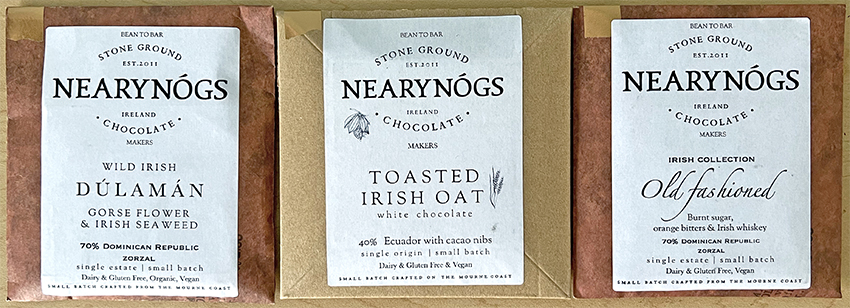
The last 3 bars in this roundup came from Ireland. NearyNógs Stoneground Chocolate Makers was established in 2011 but Chocolate Covered just started carrying them.
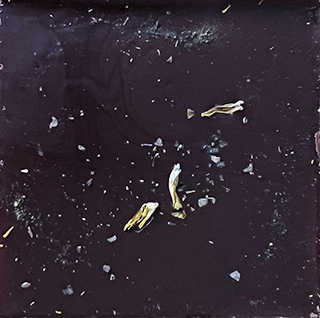
My regulars tried these bars and liked the Wild Irish Dúlamán Gorse Flower and Irish Seaweed bar best. Made with 70% cacao from the Dominican Republic, seaweed, and dried gorse flowers, it was a little grainy but smooth for stone ground chocolate.
A little salty and not sweet or bitter, the group thought it was a good savory chocolate. The other flavors were subtle and the taste kept getting better with a “clean aftertaste” as one taster declared.
The other bar made from 70% Dominican Republic cacao — the Irish Collection Old Fashioned — was flavored with burnt sugar, orange bitters, and Irish whiskey. It started out tasting lightly orange and became more orange as it melted. We didn’t taste whiskey or feel any buzzy sensation.
This one covered its inherent graininess with finely ground cacao nibs so it had a grainier texture but that seemed like a good cover to me — more chocolate! It was sweeter than the first bar but not too much and it wasn’t bitter. If you like orange chocolate this is a nice one.
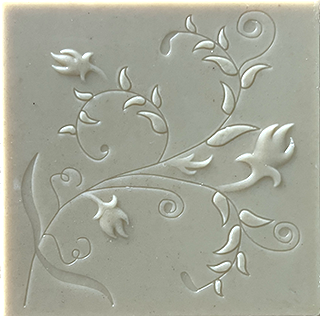
The third bar we tried from NearyNógs was a white chocolate called Toasted Irish Oat.
It was a pretty bar with their custom cacao flowers mold standing out on the grayish white chocolate and with cacao nibs sprinkled on the other side. It had a powdery texture and a strange nutty/savory flavor. None of my tasters liked it. I did like that it wasn’t a sweet bar which is often the case with white chocolate.
It didn’t have a distinct oat flavor — I think the toasted oats translated to the nutty flavor. I have to say the cacao nibs on the back nearly saved this bar. They added a little crunchiness and a slightly sweet chocolate aftertaste but it wasn’t enough to win over my crowd. We’ll stick with their dried gorse flower and seaweed bar or the Irish whiskey one.
All of this chocolate except the Belgian Chocolaterie Vandenbouhede bark and the Nói Sírius Icelandic Chocolate bar are available at Chocolate Covered. You will have to travel to find the others — Tahoe City might be the closest for the Icelandic chocolate but you will have to cross the globe for the Belgian bark — what I would call a good problem.

